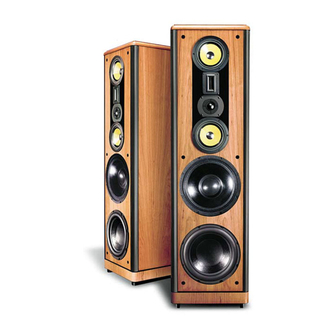
Table of Contents
Advertisement
Quick Links
Advertisement
Table of Contents

Subscribe to Our Youtube Channel
Summary of Contents for Legacy Focus
- Page 2 Warranty Unpacking/Speaker Placement Designer’s Note The Cabinetry/Our Commitment Connections/Fine-tuning Specifications Hook-Up Cables Amplifier 10. For The Tweakers 11. Biamplification...
- Page 3 Limited Warranty Legacy Audio, Inc. extends to the original owner coverage of defects in materials and workmanship for a period of 90 days from the date of purchase. To extend this warranty to 10 years, please fill out the enclosed warranty card and return to Legacy Audio.
-
Page 4: Speaker Placement
Please save this packing for future transportation. If cartons become damaged or misplaced, new ones can be purchased from Legacy Audio. The first unpacking step is to fold back the flaps at the top of the outer carton.Then carefully stand the loudspeaker on its head and slip away the outer cardboard. - Page 5 Images are clearly defined and localization is consistent with frequency. The Kevlar Hexacone drivers used in FOCUS are among the most expensive and elaborate ever developed.The cone material is more than 70 times stiffer than polypropylene and paper cones, yet weighs 30% less.An enormous motor structure and a...
- Page 6 FOCUS is endowed with low frequency dynamic capabilities among the greatest ever found in and audiophile speaker.The system’s linear bass output betters models such as the B&W 801...
-
Page 7: Our Commitment
The Cabinetry Beneath the surface of FOCUS’s elegant exterior lies rigid MDF construction. Interlocking joinery maximizes the strength of the cabinet parts. Polyester fiberfill is selected for internal damping.A sharp rap on the enclosure will leave you with little more than bruised knuckles. -
Page 8: Fine Tuning
It is recommended that switch 3 be left in the up position which converts the FOCUS from a traditional B4 alignment to a more sophisticated sixth-order Butterworth alignment, thus reducing distortion in the octave above system resonance. -
Page 9: Specifications
Specifications System Type: 7 driver, 4 way. Tweeter: 4” Ribbon. Midrange: 1.25” soft textile dome. Midwoofer: (2) 7” Kevlar®. Subwoofer: (3) 12” Polypropelene. Low Frequency Alignment: B6 Assisted. Sensitivity: 98 dB @ 2.83 V/1m. Frequency response: 16 Hz - 30 kHz +/- 2 dB. Crossover frequency (Hz): 180, 2.2k, 12k Recommended Amplification: 10 - 400 watts/channel. -
Page 10: Hook-Up Cables
Hook-up Cables The ideal conductor would have negligible resistance, inductance and capacitance. The table below shows how a few actual speaker cables measure up. Ωs/ft Cable pF/ft µH/ft 12 ga. 0.0033 0.21 14 ga. 0.0048 0.13 16 ga. 0.0079 0.18 18 ga. - Page 11 The Amplifier Ideally the loudspeaker would be among the first components selected when assembling a playback system. This would allow the user to choose an amplifier capable of delivering adequate amounts of current into the frequency dependent load presented by the loudspeaker. However, when upgrading a system, audiophiles may find themselves matching their new loudspeakers to their existing amplification.
- Page 12 If you wish to attenuate the energy in this range, simply contact Legacy Audio and we will exchange or modify your dome drivers with a resistor network that allows several soft steps of attenuation. Another situation frequently encountered is the “one speaker in the corner, the other speaker open to the dining room”...
- Page 13 Biamplification Your Legacy speakers offer the options of conventional wiring, biwiring, passive biamplification or active biamplification. The following is a summary of these options. CONVENTIONAL WIRING This format is the simplest way to connect your loudspeakers to your amplifier. A single twin-conductor cable is used to link the loudspeaker to a single channel of amplification.
- Page 14 2. Horizontal Biamping Any two stereo amplifiers may be utilized in horizontal biamplification. Many audiophiles prefer the "sweetness" of tubes on the satellite portion of the loudspeaker while favoring the "control and weight" of solid state amplifiers on the subwoofer section. The biggest drawback of such a marriage of amplification is that the two amplifiers may have different input sensitivities or output polarities.
















Need help?
Do you have a question about the Focus and is the answer not in the manual?
Questions and answers